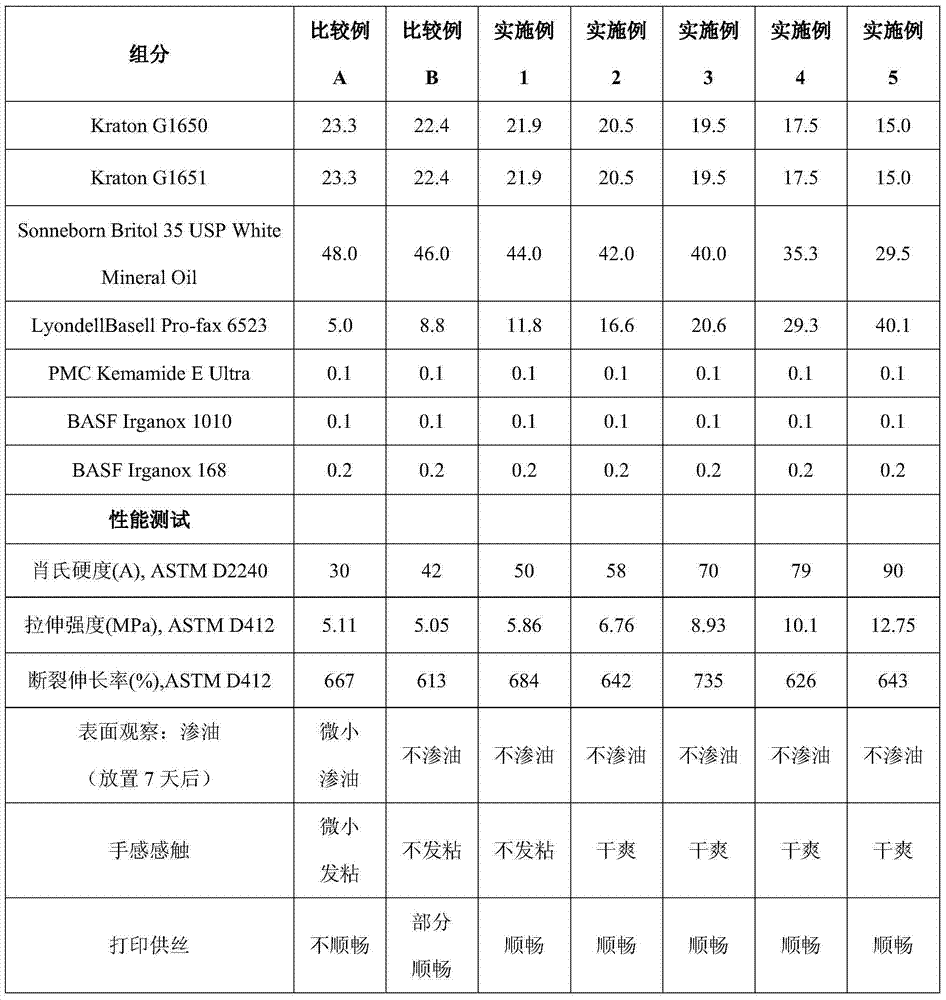Thermoplastic elastomer composition for preparing flexible printing material for three-dimensional printing rapid prototyping
A thermoplastic elastomer, three-dimensional printing technology, applied in the field of thermoplastic elastomer compositions, can solve the problems of lack of ductility, lack of soft hand feel, unsmooth printing, etc., and achieves easy process operation, wide range of raw material acquisition, and improved printing. The effect of efficiency
- Summary
- Abstract
- Description
- Claims
- Application Information
AI Technical Summary
Problems solved by technology
Method used
Image
Examples
Embodiment approach
[0076] In an exemplary embodiment, the thermoplastic elastomer composition used for preparing soft printing materials for three-dimensional printing fused deposition rapid prototyping according to the present invention includes the following components by weight percentage:
[0077] thermoplastic elastomer
30.0%~43.8%
11.8%~40.1%
softener
29.5%~44.0%
0.1%
0.3%
[0078] The thermoplastic elastomer is selected from any of the above-mentioned thermoplastic elastomers, preferably a styrene-based thermoplastic elastomer, such as SEBS, which can be a combination of Kraton G1650 and Kraton G1651, and the weight ratio of the two can be 1:1, as in Example 1 ~5 described.
[0079] The polyolefin is selected from polypropylene, polyethylene and other olefin oligomers. Polypropylene is preferred.
[0080] The softening agent is selected from white mineral oil, paraffin oil, silicone oil, cas...
Embodiment 1~ Embodiment 5
[0118] 1. Materials and their sources: as shown in Table 2.
[0119] Table 2:
[0120]
[0121] 2. Formulation, preparation method and performance test
[0122] Formula and performance test: as shown in Table 2.
[0123] Preparation method: according to the dosage ratio shown in Table 3, put each component in a mixer, fully mix under normal temperature conditions to form a uniformly mixed material, and put it into the compound with a length-to-diameter ratio (L / D) of 44 or more Parallel twin-screw extruder, melting and plasticizing at 180-220°C to form a melt; the melt is further uniformly mixed, extruded through the mouth of the parallel twin-screw extruder, and then using a commonly used underwater pelletizer Granulation is carried out to obtain soft printing materials in the form of soft particles.
[0124] The above-mentioned soft particles are plasticized and melted again by a common single-screw extruder at 180-220°C to form a melt; after the melt passes through a ...
Embodiment 6~10
[0129] 1. Materials and sources: as shown in Table 4.
[0130] Table 4:
[0131] purpose
Chemical name / Common name
Trade name / source
[0132] thermoplastic elastomer
SEPS
Septon2063
polyolefin
Formalene 1102KR
softener
Calumet Calsol5550
Erucamide
PMC Kemamide B Powder
Tetrakis[β-(3,5-di-tert-butyl-4-hydroxyphenyl)propionate]pentaerythritol ester
BASF Irganox 1010
antioxidant
Tris(2.4-di-tert-butylphenyl)phosphite
BASF Irganox 168
[0133] 2. Formulation and performance test: as shown in Table 5. Preparation method: similar to Examples 1-5.
[0134] table 5:
[0135]
PUM
 Login to View More
Login to View More Abstract
Description
Claims
Application Information
 Login to View More
Login to View More - R&D
- Intellectual Property
- Life Sciences
- Materials
- Tech Scout
- Unparalleled Data Quality
- Higher Quality Content
- 60% Fewer Hallucinations
Browse by: Latest US Patents, China's latest patents, Technical Efficacy Thesaurus, Application Domain, Technology Topic, Popular Technical Reports.
© 2025 PatSnap. All rights reserved.Legal|Privacy policy|Modern Slavery Act Transparency Statement|Sitemap|About US| Contact US: help@patsnap.com



